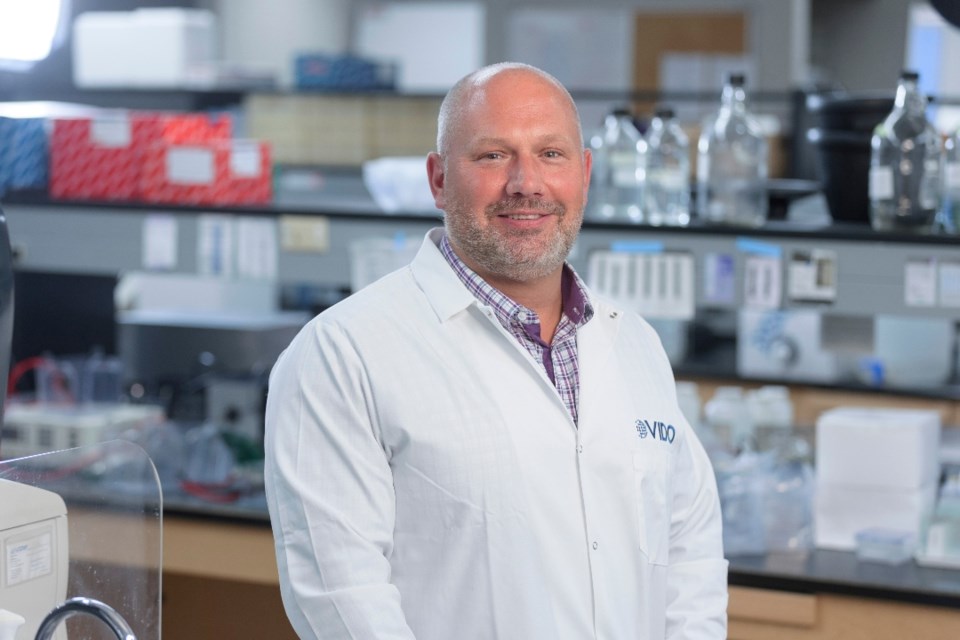SASKATOON – Even Dr. Scott Napper (PhD) uses words such as scary when describing the focus of his research — a group of diseases caused when otherwise innocuous proteins go rogue, creating conditions that are always fatal and currently untreatable.
“But that’s what I love about it – it’s so interesting and so very important,” said Napper, a scientist with the Vaccine and Infectious Disease Organization (VIDO) at the University of Saskatchewan (USask).
Napper has a lead role in the search for vaccines to treat diseases caused by misfolded proteins. His original research focused on prion diseases, which include mad cow disease, scrapie in sheep, and chronic wasting disease (CWD) in deer and elk.
However, several similar neurodegenerative diseases in humans are also on his radar, including Alzheimer’s, Huntington’s, Parkinson’s, and amyotrophic lateral sclerosis (Lou Gehrig’s Disease).
“Is CWD the priority? Yes. Is Alzheimer’s the priority? Yes. We do this work on both human and animal vaccines in parallel,” he said.
Napper explained these diseases result when a protein misfolds and takes on new and devastating characteristics. And once misfolded, the new protein becomes self-propagating.
When the misfold comes in contact with a properly folded version of itself, that protein also misfolds, “so one becomes two and two become four, and you get a cascade of misfolding that ends in deadly disease.”
Prion diseases first rose to attention in the early 1950s with the discovery of Kuru, a neurodegenerative disease found in the Fore people of Papua New Guinea, said Napper. It was linked to funerary cannibalism—the Fore people cooked and ate their deceased family members, thus spreading the disease.
When the cause of Kuru was identified about 20 years later as a proteinaceous infectious particle or prion, “it was mind blowing,” said Napper. “It completely changed the way we think about infectious diseases because this is not a bacteria or virus.”
This prion-like mechanism is now known to be responsible for other human neurodegenerative diseases such as Alzheimer’s. And the quest for a cure recently got a boost.
The Alberta Conservation Association, in partnership with Alberta Environment and Parks, and Saskatchewan’s Ministry of Environment, has provided $1.2 million to fund research on an oral vaccine to manage CWD, which poses significant risk to wild populations in four provinces and 28 states.
A team of scientists at four western Canadian universities, including Napper, Dr. Philip Griebel (DVM, PhD) and Dr. Suresh Tikoo (DVM, PhD) at VIDO, as well as Dr. Sidney Hayes (PhD) in the College of Medicine, aim to develop oral vaccines for CWD that can be released in affected habitats. The other researchers are from the Universities of British Columbia, Alberta and Calgary.
The scientists will work collaboratively with wildlife groups to develop and deliver an effective real-world solution.
“We’re in lab coats and they’re in camo, but we can all work together,” Napper said.
On the human front, the Weston Family Foundation through the Weston Brain Institute is providing $1.2 million to Napper and three research colleagues at other Canadian universities to develop a vaccine for misfolded protein diseases in humans. Building on previous developments, the scientists will generate antibodies that attach to misfolded proteins—one has already been selected for pre-clinical development—to prevent disease development.
In both cases, Napper appreciates the team approach.
“Just as we saw with COVID when the global science community came together to develop a vaccine, we’re better, stronger and smarter if we work together, and leave our self-interest and egos at the door.”
That’s not to say the work will be easy, but the early results are highly encouraging, Napper said. “The pipeline is there, and once we have the target protein, we’ve been able to get the required types of immune responses. All the diseases we’ve talked about have a different target protein but developing the vaccines all use similar processes.”
Napper, who is also a professor of biochemistry in the USask College of Medicine, believes VIDO’s unique culture and expertise will make it a significant contributor.
Created in 1975 to focus on infectious diseases in Canada’s livestock industry, VIDO expanded its mission to include research and vaccine development related to human diseases, with COVID-19 being one example. The breadth of talent among VIDO scientists means the organization “can take a team approach to complex problems,” he said.
“I’m not an immunologist but the guy in the office next door is, and there’s a scientist who’s been developing oral vaccines for 20 years just one floor down. We all want to make the world a better place.”
Napper admitted it’s faster to develop and market a vaccine for animals than for humans, “so it isn’t unreasonable to imagine a CWD vaccine in seven to 10 years.” A human vaccine will take longer but Napper is undeterred.
“Our initial success might be to simply slow down the progression of the diseases, but we’ll take incremental successes as they come. There’s hope.”
— Submitted by USask media relations




